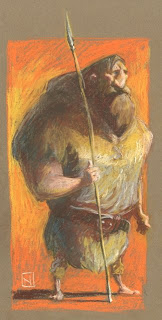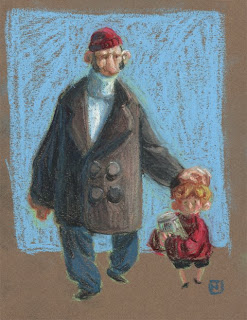NOAH KLOCEK INTERVIEW
Sketch Artist / Designer For Pixar Animation Studios
Monday, May 18, 2009
BROUGHT TO YOU BY THE CHARACTER DESIGN BLOGSPOT
IF YOU WOULD LIKE TO SEE MORE INTERVIEWS GO TO THE HOME PAGE BY CLICKING HERE
Noah Klocek Interview

Tell me a little bit about yourself, about your life? What helped prepare you to become the artist that you are today?
Both my parents are great artists in there own right. Both have masters degrees in fine art, but ended up teaching for their careers. I think I inherited the drawing bug from them, but they made sure I did not just focus on art. After high school they pushed me to try out other field instead of just heading of to art school. So I spent three years at a junior collage trying everything from wild life biology through landscape architecture, but nothing seemed to fit right. I ended up deciding art school was what I wanted, so headed of to San Jose State University, where I got my BFA with my parents blessing. All of that mixed with a tone of painting and drawing made me the artist I am today.
How do you go about drawing, and what goes through your mind, from start to end?
This is a difficult question, because it depends heavily on the type of drawing. If I'm outside doing plein air pastels, I don't go through the same process I do when I'm designing for work. When drawing for design I always start with story. Communication is probably a better word than story, but I focus on what the character or set I am designing is saying and what I want it to be saying. I generally do a lot of research at the outset. I try and find photos or other paintings that are telling a similar story. I rarely draw directly from the reference, for me that usually kills the drawing, but I spend some time trying to internalize the reference.
Then I start to draw. I always try to work big to small. Big shapes to small shapes, loose to tight etc. I do not try and finish a small part then move on to another small part I work on the drawing as a whole. I also try to find the story in the character or set from as many angles as possible, it can take a while to hone in on a direction I like. Once all the pieces start falling in to place I kind of go on cruise control. I don't take much of my design work to a super polished finish there is usually no reason to do so. I do however polish my pastel illustration work, but most of the finishing steps are just pure fun. At the polishing faze I have already been through the struggle to tell the story and communicate my idea through composition, design, shape, color and in the final stage I'm just playing with the pastels.
What is a typical day for you, and who are the people you work with?
A typical day for me is filled with some drawing, a lot of problem solving and a ton of meetings. I get to work early to give myself time to draw uninterrupted, around 9:00 the meetings start and the rest of the day is drawing painting and problem solving in between meetings. I work about 10 to 12 hours a day most days.
What are some of the things that you have worked on?
Most of the work I have done is film design work or Matte Painting. I did a lot of design work on Wall-e as well as the Pixar's next film Up. I have done a lot of matte paintings for Dreamworks on Shrek 2 and Madagascar and even more Paintings for ILM on Pirates of the Caribbean, T3 and the Hulk.
I am working on several children's books, and freelance illustrations, but it is slow going as most of my time is spent at Pixar. A lot of my work can be seen in the Wall-e and Up art of books.
What are you working on now? (if you can tell us)
I just finished production designing Pixar's next short Partly Cloudy.
Who do you think are some of the top artists out there?
I have to say, I'm blow away daily by all of my colleagues here at Pixar, but my tastes outside of the film industry lean towards old school illustrators like Gary Kelley and Sergio Martinez. I'm a huge fan of Man Arenas, Neil Ross, Alberto Mielgo as well as a host of others in the art blog world.
Could you talk about your process in coloring your art, as well as the types of tools or media that you use?
I do two types of coloring one is in Photoshop and the other in pastel. I approach them in a similar way, that is I always try to work large to small. I try and lay in all of the big shapes of color first so that I can establish my value range. Then I go back with medium size shapes then small. I do however prefer working in pastel for two reasons. First it forces me to plan more, I can’t just throw color around. I only have a few layers to work with in pastel and once you put down a dark color it's almost impossible to remove. Secondly I love having a real piece of artwork when I'm done. There is something magical to me about an original piece of art, it's powerful yet incredibly fragile at the same time and there is only one, it can never be duplicated exactly again. It's kind of a snapshot for me of that moment in my artistic career.
What part of designing is most fun and easy, and what is most hard?
For me the initial design and planning phase is the most difficult. I spend a lot of time worrying about the communication and story of the piece then the design of all the elements. After that I spend a lot of time trying to get each part to work together and not loose the strength of story or design. I may do two hundred drawings for one final illustration. Once I get all the elements in place and the design and story seems to be working the rest flows pretty easily. As far as which is more fun it's hard to say, the break-throughs during the design faze are incredibly rewarding, but as far as just enjoying the act of drawing and painting the final stages of and illustration are the most fun.
What are some of the things that you do to keep yourself creative?
The number one thing I do to keep myself creative is to always maintain a personal project going outside work. The artwork I create for film is not for me personally; instead it is in the service of a film. As a result it can be tough when, I'm asked to change direction on a piece or toss it out all together. It's important to learn early on how to take criticism, how to put all your energy and heart into a design and then let it go for the good of the film. I find that if I always have a little project of my own on the side, I stay grounded. Just one little project gives me my own little world where I can do exactly as I want creatively.
What are some of your favorite pieces of art work that you have seen?
When I was still in school, I went to London with a bunch of the illustration department at San Jose State. Our Professors had set up a visit at the Victoria and Albert museum where one of the curators brought out several huge boxes full of E.H. Shaper's sketches and original or for Winnie the Pooh, I will never forget that.
What is your most favorite subject to draw? And why?
I don't have anything that specific that I like to draw all the time, I am however always trying to get better at what I find as my weakest subjects. Usually I'll work on character for a few months then feel I'm neglecting color, followed by environments.
What inspired you to become an Artist?
My parents inspired me to become and artist.
What are some of the neat things you have learned from other artists that you have worked with or seen?
That list is endless, but I think the best thing I have learned form the artist I work with is that there is no end to learning about art. I'm constantly inspired to push myself artistically by the other artist I work with.
What are some of your favorite websites that you go to?
I spend most of my internet time blog surfing. There are a number of blogs I visit on a regular basis that I find give me a place to start surfing. This blog is a great resource, I also like drawn.ca as well as linesandcolors.com.
What wisdom could you give us, about being an Artist? Do you have any tips you could give?
I don't know about wisdom, but I would say that the best advice I have, is to challenge oneself as an artist. Don't just stay in your comfort zone, or only look at artwork you know and love. Go to the museum and try to figure out the value and the strength in artwork you are not immediately drawn to. Tackle the artistic subjects that scare you the most, and find inspiration wherever you can. I have learned much more from work that I struggled to understand than work that I loved immediately.
If people would like to contact you, how would you like to be contacted?
Email is the best way to contact me, my email in on both my website and blog. No spam please.
www.imageblockstudio.com
www.imageblock.blogspot.com
Finally, do you have any of your art work for sale (sketchbooks, prints, or anything) for people that like your work can know where and when to buy it?
Unfortunately I do not, I keep getting emails urging me to make a book of my pastels, but I just have not found the time.
Subscribe to:
Comments (Atom)































